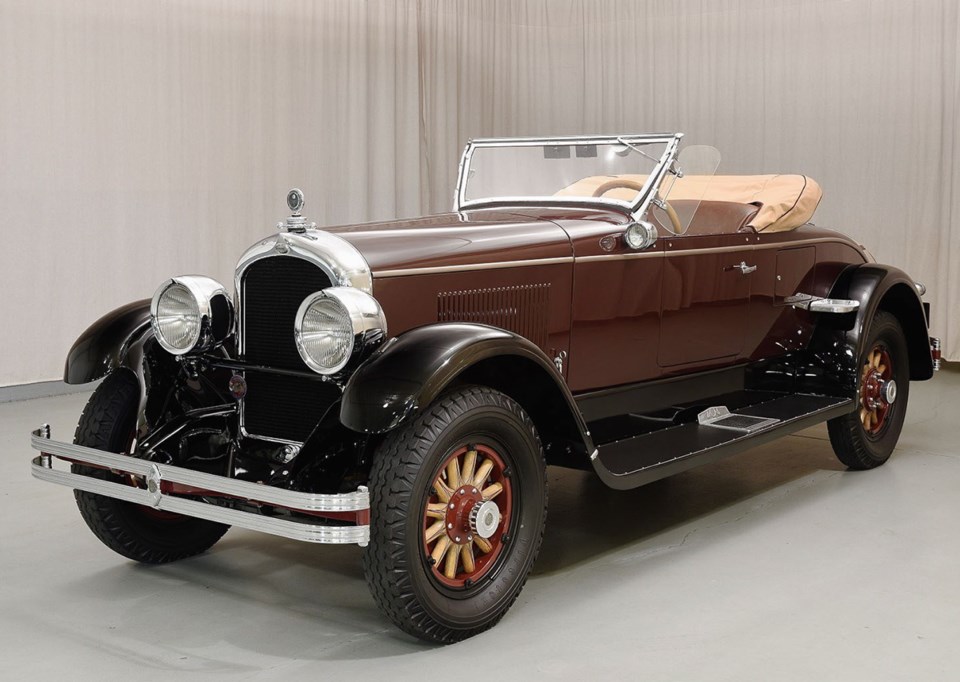Although Marmon is now largely forgotten, it was one of the finer names in early American automobiles. Its accomplishments included winning the first Indianapolis 500, a fabulous award-winning aluminum V-16 engine, setting a cross-country speed record and the rear-view mirror.
Its roots were planted in Richmond, Indiana, in 1851 when Daniel Marmon and a Mr. Nordyke began manufacturing millstones. They relocated to Indianapolis in 1876 and advanced to making flour-milling machinery.
Early in the 20th century, Daniel’s son, Howard, a mechanical engineering graduate from University of California, Berkeley, became Marmon’s chief engineer at age 23. Older brother Walter, also an engineer, managed the business.
Although flour machinery was profitable, it didn’t excite Howard. He was intrigued by the emerging automobile, so in a corner of the factory he built his first car in 1902. His ingenuity was already apparent in the air-cooled V-twin engine’s full pressure lubrication and overhead valves.
Howard’s second car in 1903 had an air-cooled V-4. At the request of friends he built six more, and Marmon was in the automobile business. Production increased to 25 in 1905, and Howard began experimenting with different engine configurations.
After trying vee-type sixes and eights he settled on conventional water cooled, inline designs. Several new Marmons were introduced, including the 1909 Model 32, which also came in a racing version called the Marmon Wasp for its long yellow pointed tail.
The Wasp established Marmon’s reputation for durability and speed and brought priceless publicity by winning the first Indianapolis 500 in 1911 driven by company engineer Ray Harroun. The ingenious Harroun dispensed with the usual riding mechanic and monitored activities behind him with a mirror mounted on the cowl, said to be the first use of a rear-view mirror.
The Model 32 was good enough to remain in production for many years. In 1916, Marmon introduced the Model 34, an evolution of the Model 32 with an overhead valve in-line six. More advanced thinking was evident in its almost entirely aluminum engine.
The Model 34 also had an aluminum body, hood and radiator, and although it was large with a 3531 mm (139 in.) wheelbase in the touring model, it weighed just 1,633 kg (3,600 lb).
In 1916, Howard Marmon sent a team of drivers in Marmon 34s across the U.S. in pursuit of the trans-continental record. They completed it in less than six days, beating the legendary Cannon Ball Baker’s Cadillac time by 41 hours. The Model 34 remained in production until 1924 and its derivative Models 74 and 75 until 1928.
By 1924, Marmon sales and finances were flagging until new money came from George Williams, former president of Wire Wheel Corp. of America. To stimulate interest, Marmon began selling closed cars at prices close to open ones and sales rose from some 2,600 in 1924 to almost 4,500 in both 1925 and 1926.
Williams was convinced they needed a lower-priced car, so in 1927, Marmon introduced the Little Eight. It lasted only one year. This was followed by the Roosevelt in 1929, named for former U.S. president Theodore Roosevelt. It was the first straight-eight available at less than $1,000, and pushed sales to more than 15,000 in 1928 and some 22,000 in 1929.
This encouraged Marmon to adopt straight-eights exclusively. It had seemed like the right decision at the time, but the onset of the Depression sent Marmon and others into serious sales declines. The Roosevelt lasted only a couple of years.
While Williams’s less-expensive models had kept Marmon going, Howard Marmon had a grander vision, the Marmon Sixteen. It appeared in 1931, and although not the first V-16 — Cadillac’s arrived in 1930 — the Marmon engine was more powerful and striking in appearance.
The V-16 would have been the pride of any engineer, proved by winning the Society of Automotive Engineers’ annual design award. The 8.0 litre (491 cu in.), overhead valve, aluminum engine’s 200 horsepower was second only to Duesenberg’s 265.
Because many parts including cylinder block, heads, oil pan and valve covers were aluminum, the V-16 engine weighed only 422 kg (930 lb), a remarkable power-to-weight ratio. Narrow 45-degree cylinder banks let it fit under the slim hoods of the day.
It had wet, pressed-in steel cylinder sleeves and fork-and-blade connecting rods rather than the now universal side-by-side type.
Although it was magnificently engineered, the Marmon Sixteen arrived just as the Depression was sapping the automobile economy and dramatically shrinking the market for $5,000-plus cars. Marmon Motor Car Co. went into receivership in 1933 after building fewer than 400 of the glorious Sixteens.
Although Marmon was out of the car business, the name lived until 1963 in Marmon-Herrington buses, four-wheel-drive commercial vehicles and four-wheel-drive conversion kits for trucks.



